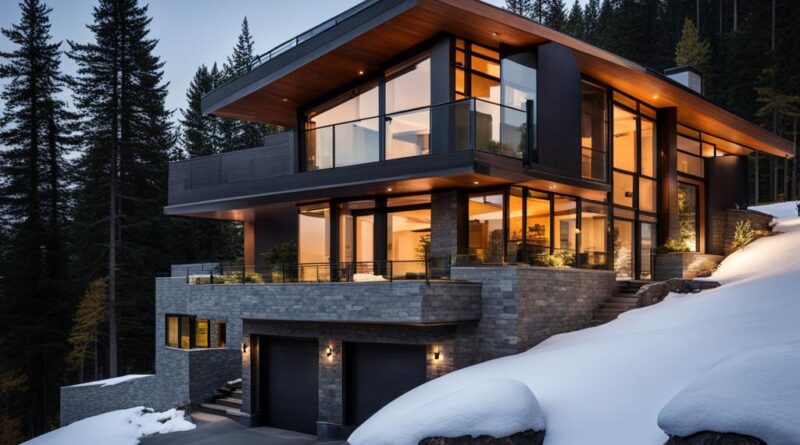Modern Mountain House Design & Living Tips
The modern mountain house design combines elements of rustic charm with sleek and contemporary aesthetics. This style blends the natural beauty of mountain landscapes with modern living, creating a harmonious and luxurious retreat. In this article, we will explore essential tips for designing a modern mountain house, including the use of natural materials, open floor plans, seamless indoor-outdoor connections, and sustainable features. Whether you are renovating an existing mountain home or building a new one, these design tips will help you create the ultimate modern mountain retreat.
Key Takeaways:
- Modern mountain house design combines rustic charm with contemporary aesthetics.
- Use natural materials like wood and stone to create an authentic mountain retreat atmosphere.
- Open floor plans and ample natural light enhance the spaciousness and connection to nature.
- Incorporate outdoor spaces like balconies and decks for enjoying the surrounding views.
- Integrate sustainable features and smart technologies for energy efficiency and convenience.
Key Elements of Mountain Modern Style
Mountain modern style, also known as mountain contemporary style, is a design aesthetic that seamlessly merges rustic elements inspired by mountain landscapes with modern design principles. This style embraces the beauty of nature while infusing it with sleek and luxurious touches.
The key elements of mountain modern style include:
- Rustic Elements: The use of natural materials such as wood, stone, and fur adds a touch of rugged charm to the space. These materials bring the essence of the mountains indoors, creating a warm and inviting atmosphere.
- Modern Design: Clean lines and minimal ornamentation are hallmarks of mountain modern style. The focus is on simplicity and elegance, allowing the natural beauty of the space to take center stage.
- Natural Materials: From rich hardwood floors to textured stone accents, natural materials are at the forefront of mountain modern design. These materials provide a sense of authenticity and create a strong connection to the surrounding environment.
- Rugged Textures: Incorporating textures such as rough-hewn wood, natural stone, and cozy fur accents adds depth and visual interest to the space. These rugged textures contrast beautifully with the clean lines and smooth surfaces of modern design.
- Ample Natural Light: The use of large windows and skylights is essential in mountain modern style. It allows abundant natural light to flood the space, creating a bright and airy atmosphere that blurs the distinction between indoors and outdoors.
- Clean Lines: Mountain modern style embraces simplicity and precision. Clean lines are a defining characteristic, creating a sense of order and sophistication in the space.
- Minimal Ornamentation: Ornate details take a backseat in mountain modern style. Instead, the focus is on creating a sleek and uncluttered space that highlights the beauty of the natural materials and architectural elements.
The image above showcases the essence of mountain modern style, with its seamless blend of rustic elements, natural materials, clean lines, and ample natural light.
Incorporating Natural Materials in Mountain Modern Design
Natural materials play an essential role in mountain modern home designs, seamlessly blending the beauty of nature with contemporary aesthetics. These materials not only add warmth and authenticity but also create a strong connection to the surrounding environment. By incorporating natural materials like wood, stone, fur, natural fibers, and leather, you can transform your modern home into a true mountain retreat.
Wood
Wood is one of the primary natural materials used in mountain modern design. It brings a sense of warmth, texture, and visual appeal to the space. Wood can be used for a variety of purposes, including flooring, cabinetry, furniture, and ceiling beams. Whether it’s reclaimed barn wood, rich oak, or elegant walnut, incorporating wood elements adds a touch of natural beauty to your modern mountain home.
Stone
Stone is another natural material that adds a rustic yet luxurious feel to mountain modern design. It can be used for countertops, backsplashes, and fireplace surrounds, creating focal points that exude natural beauty and timeless elegance. Whether you choose granite, marble, or slate, incorporating stone elements brings a sense of ruggedness and sophistication to your modern mountain home.
Fur
Fur accents are a perfect way to add texture and coziness to your modern mountain home. Pillows, throws, and rugs made from natural fur create a warm and inviting atmosphere. These accents not only provide comfort but also add a touch of luxury to your space, making it feel like a true mountain retreat.
Natural Fibers
Utilizing natural fibers, such as jute and sisal, adds a touch of organic charm to your modern mountain home. These fibers are commonly used for area rugs and window treatments, providing a soft and natural texture that enhances the overall aesthetic. Incorporating these natural fibers brings a sense of depth and warmth to your space.
Leather
Leather upholstery is a classic choice that adds a touch of luxury to your modern mountain home. Whether it’s leather sofas, chairs, or ottomans, incorporating leather furniture creates a sense of sophistication and indulgence. The richness and durability of leather make it a perfect addition to your mountain modern design.
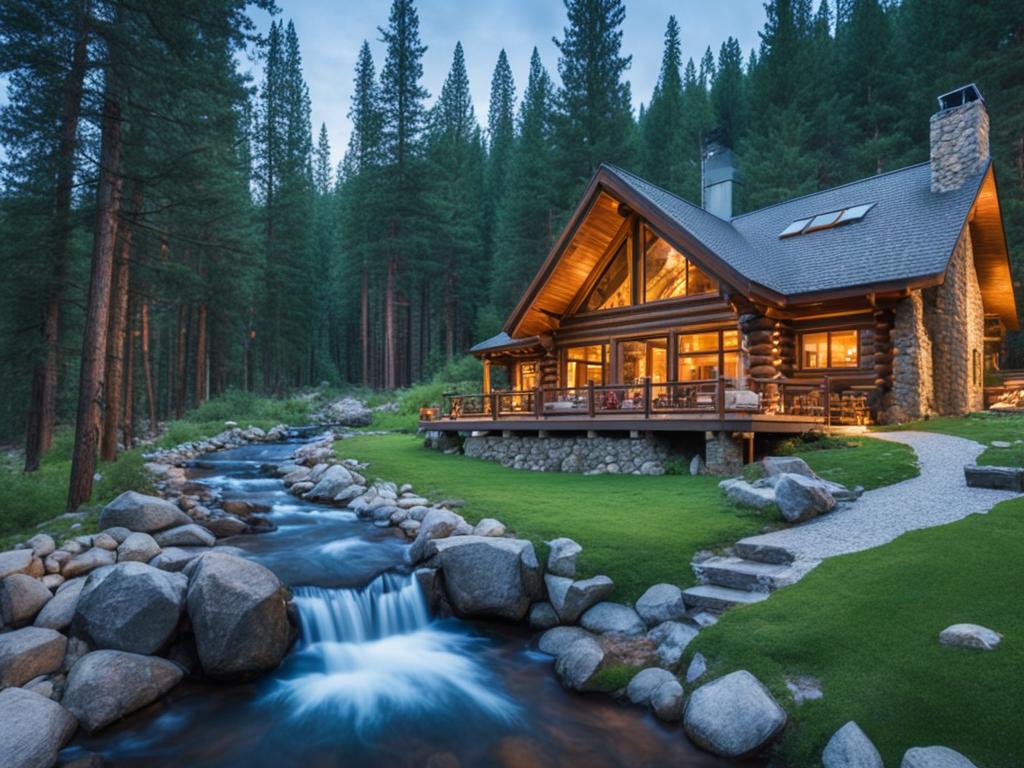
Incorporating these natural materials into your mountain modern design creates a harmonious blend of rustic and contemporary elements, bringing the beauty of nature into your living space. Whether it’s the warmth of wood, the elegance of stone, the coziness of fur, the organic charm of natural fibers, or the luxury of leather, each material adds depth and character to your modern mountain home.
Creating a Serene Color Palette for Mountain Home Interiors
Mountain home interior design is all about capturing the peaceful and earthy essence of nature. A restrained color palette primarily composed of calming neutrals sets the foundation for this style. Shades of white, beige, gray, and brown create a serene backdrop that allows artwork and unique accessories to add depth and personality.
While accent colors like blue, red, yellow, and green can be used, they are kept subdued to harmonize with the serene beauty of the mountain environment. By using an accent color sparingly, it can serve as a focal point and bring a subtle pop of color to the space. For example, a deep blue throw pillow or a piece of artwork with hints of red can add visual interest without overwhelming the overall tranquility of the design.
When incorporating accent colors, it’s important to consider their compatibility with the surrounding neutral tones. Choosing colors that appear in the natural landscape, such as shades of blue inspired by the sky or greens reminiscent of the forest, can further enhance the connection between the interior space and its mountainous surroundings.
Overall, the right combination of neutral and accent colors can create a harmonious and inviting atmosphere in your mountain home, evoking a sense of calm and tranquility that perfectly complements the surrounding natural beauty.
Embracing Natural Light and Open Floor Plans
In modern mountain homes, natural light takes center stage, creating a bright and inviting atmosphere. One of the key features that allows natural light to flood the space is the use of oversized windows. These expansive windows not only provide breathtaking unobstructed views of the surrounding mountains and forests but also act as portals, seamlessly connecting the interior with the serene beauty of the outdoors.
Open floor plans are another hallmark element of mountain modern design, contributing to the abundance of natural light and the sense of spaciousness. By eliminating unnecessary walls and barriers, open floor plans allow light to flow freely throughout the home, illuminating every corner. This design choice not only enhances the overall brightness of the space but also provides unobstructed views from one area to another, creating a seamless connection between different living spaces.
Bringing the Outdoors In: Balconies, Decks, and Porches
In a modern mountain home, outdoor spaces are seamlessly integrated with the indoor living areas, creating a seamless connection to nature and maximizing the enjoyment of the surrounding views. Balconies, upper-level decks, and porches are essential features that provide comfortable and accessible areas for relaxation, entertainment, and appreciation of the natural beauty.
Imagine sipping your morning coffee on a spacious balcony as you take in the breathtaking mountain vistas. These outdoor spaces also serve as amazing entertaining areas for hosting gatherings with friends and family, whether it’s a cozy dinner under the stars or a lively barbecue.
One of the key elements in designing these outdoor spaces is the incorporation of roof overhangs. These roof overhangs not only blend the outdoor and indoor areas seamlessly, but they also provide shade and protection from the elements, allowing you to enjoy your outdoor getaway in any weather.
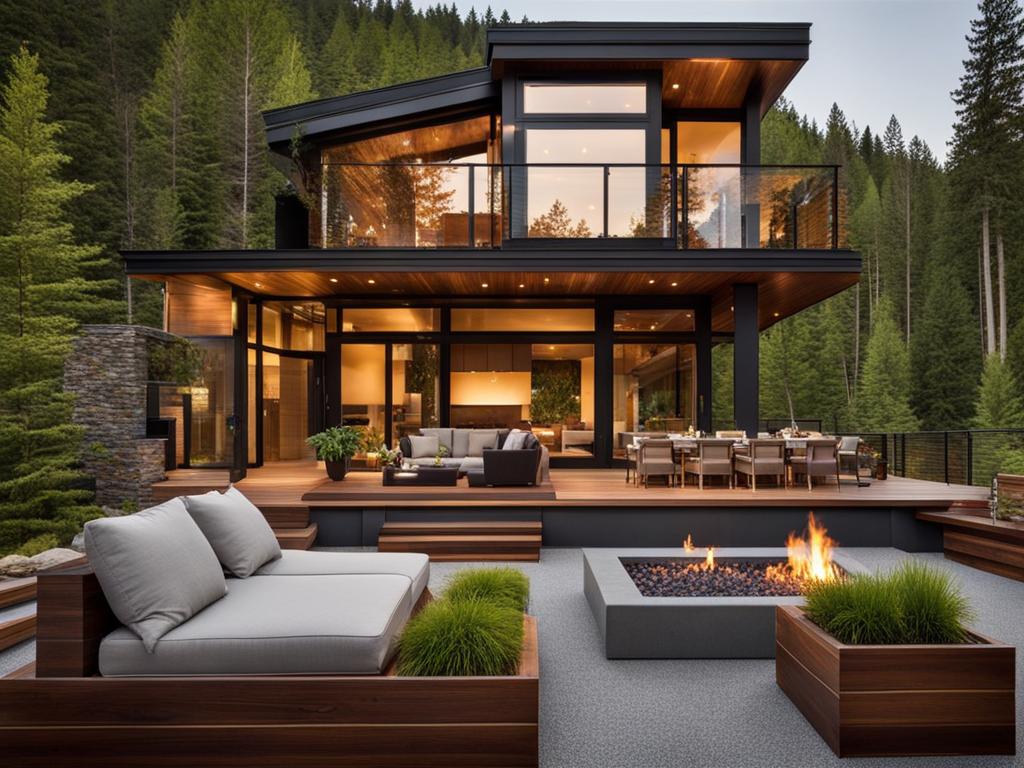
By embracing balconies, upper-level decks, and porches, a modern mountain home creates an inviting and connected atmosphere, blurring the boundaries between indoor and outdoor living. These spaces allow you to fully immerse yourself in the natural environment while providing endless opportunities for relaxation, entertainment, and creating memories.
Choosing the Right Roof Design for Mountain Homes
The choice of roof design is crucial in modern mountain home construction. Sloped roofs and flat roofs are two popular options with different practicality considerations, depending on the region and climate. Understanding the advantages and characteristics of each can help you decide which design will best suit your needs.
Sloped Roofs for Practicality in Snowy Regions
In snowy regions, sloped roofs are a practical choice for mountain homes. The angled design allows snow to easily slide off the roof, preventing large accumulations and reducing the risk of structural damage. Sloped roofs also contribute to the overall aesthetic of mountain residences, creating striking interior profiles that add visual interest and architectural beauty.
Flat Roofs for a Modern Look in Milder Regions
While sloped roofs are commonly associated with mountain homes, flat roofs have become increasingly prominent in modern architecture. In regions with milder weather and less snowfall, flat roofs can be adapted for mountain modern homes, offering a sleek and contemporary look. Flat roofs provide a clean and minimalist aesthetic, blending harmoniously with the overall style of the home.
Consider Functionality and Visual Appeal
When choosing the right roof design for your mountain home, it’s essential to consider both functionality and visual appeal. Sloped roofs offer practical benefits in snowy regions, ensuring snow shedding and protecting the structural integrity of the home. On the other hand, flat roofs provide a modern and elegant look, particularly suitable for regions with milder weather conditions.
Ultimately, the roof design should complement the overall style and architecture of your modern mountain home, creating a cohesive and harmonious aesthetic that aligns with your vision.
| Roof Design | Advantages | Considerations |
|---|---|---|
| Sloped Roofs |
|
|
| Flat Roofs |
|
|
Creating Depth and Dimension with Two-Tone Flooring
Two-tone flooring is a popular design choice in modern mountain homes, as it adds visual interest and depth to the space. This technique involves combining different materials, such as wood and stone, to create distinct sections or patterns on the floor. By incorporating a wood and stone combination, you can create an intriguing contrast that enhances the overall aesthetic of your modern mountain home.
The use of two-tone flooring not only adds dimension to the space but also creates a sense of separation between different areas of the home. For example, you can have a beautiful hardwood floor in the living area that seamlessly transitions to a stone floor in the entryway or kitchen.
“Two-tone flooring adds both dimension and intrigue to the space, enhancing the overall aesthetic of the modern mountain home.”
This unique flooring design allows for the creation of visually appealing patterns and sections that break up the monotony of a single flooring material. It adds depth and visual complexity to your home’s design, making it more captivating and inviting.
Additionally, the combination of wood and stone provides a harmonious blend of natural elements. The warmth and richness of the wood flooring complement the rugged and earthy texture of the stone, creating a balanced and captivating atmosphere.
To further enhance the visual impact of the two-tone flooring, you can experiment with different patterns, such as alternating strips or geometric shapes. This customization adds a personal touch to your modern mountain home, making it truly unique and reflective of your style.
Creating depth and dimension with two-tone flooring is a design choice that not only enhances the visual appeal of your modern mountain home but also adds a sense of luxury and sophistication. It is a creative way to incorporate the beauty of both wood and stone, elevating the overall aesthetic of your living space.
Two-Tone Flooring Examples
| Living Area | Entryway |
|---|---|
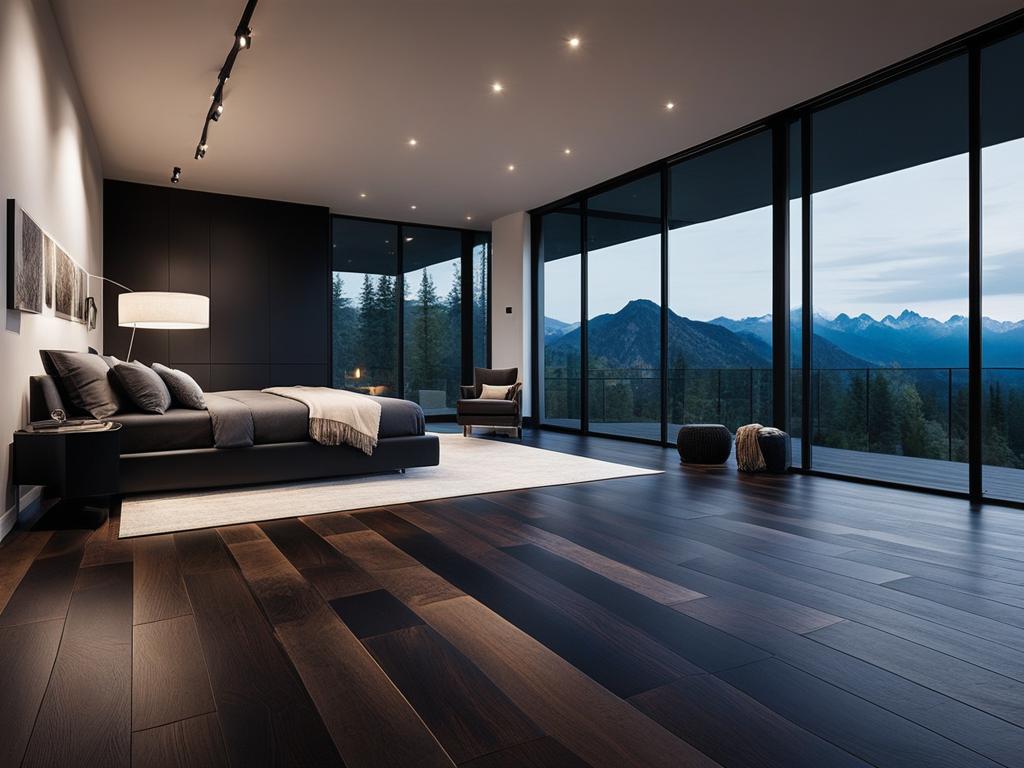 |
 |
Designing with Local and Vintage Treasures
Incorporating local and vintage treasures into your modern mountain home design adds a personal touch and unique character to the space. By sourcing materials like wood and stone from local vendors, you not only support the local trade but also give your home a sense of place and a deeper connection to the surrounding area.
When it comes to antique and vintage pieces, they offer more than just aesthetic appeal. They provide glimpses into the past and make for great conversation starters. Whether it’s a classic piece of furniture or a unique decor item, these treasures add history, charm, and a touch of nostalgia to your modern mountain home.
To truly personalize your space, consider keeping and integrating parts of the home’s original architecture. This can include preserving and showcasing historic elements like exposed brick, original beams, or intricate moldings. By blending these historic elements with modern design, you can tell a story and create a truly one-of-a-kind mountain home.
Benefits of Designing with Local and Vintage Treasures:
- Sense of Place: Sourcing local materials creates a deeper connection to the surrounding area and supports the local economy.
- Unique Character: Antique and vintage pieces add charm, history, and conversation starters to your space.
- Personalization: Keeping and integrating parts of the home’s original architecture adds a personal touch and tells a story.
- Blend of Past and Present: Combining historic elements with modern design creates a unique and harmonious aesthetic.
“Designing a modern mountain home is an opportunity to honor the past while embracing the future. By incorporating local and vintage treasures, you can create a space that is both timeless and uniquely yours.” – Interior Designer, Emma Thompson
Designing with local and vintage treasures allows you to infuse your modern mountain home with character, history, and a sense of place. It’s all about creating a space that is not only visually stunning but also truly reflective of your personal style and connection to the surrounding environment.
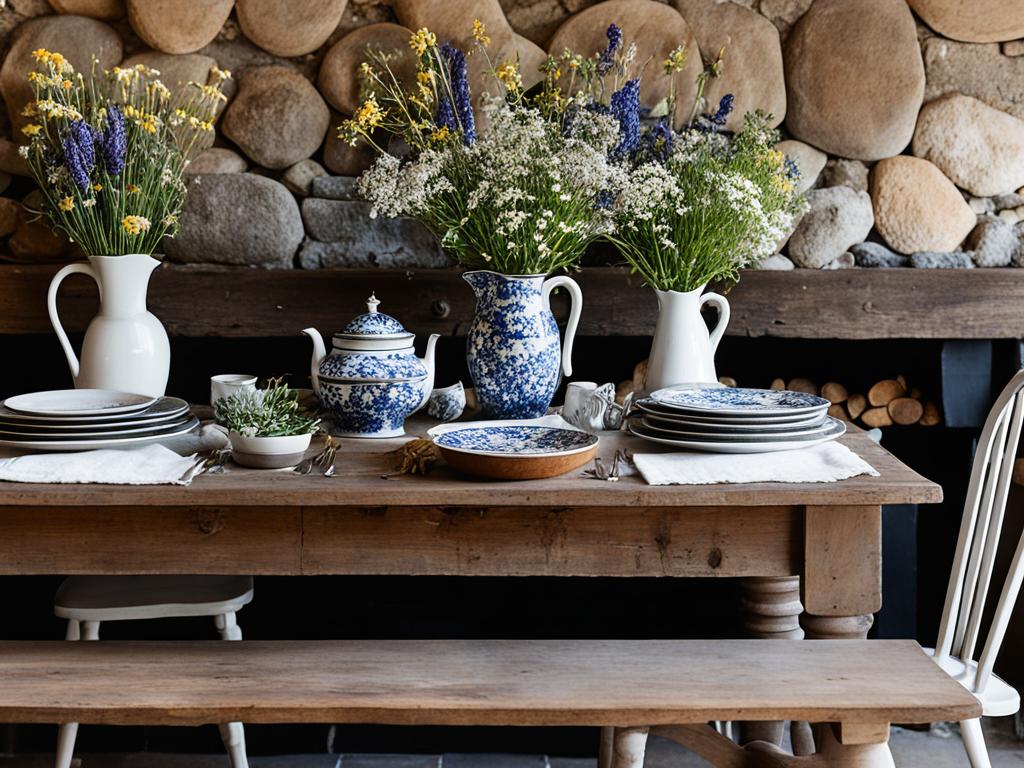
Integrating Smart and Sustainable Features
Modern mountain homes are not only about aesthetics but also about functionality and sustainability. By incorporating smart home features and energy-efficient appliances, you can create a living environment that simplifies your daily life while also reducing energy costs. Additionally, integrating skylights and LED lightbulbs enhances the sustainability of your home, contributing to a greener lifestyle.
Smart home features such as automated lighting, thermostat controls, and security systems offer convenience and energy savings. With these features, you can control and monitor various aspects of your home remotely, enhancing your overall comfort and security.
“Integrating smart home features in modern mountain homes ensures convenience, energy efficiency, and peace of mind.”
Energy-efficient appliances are an essential component of sustainable living. By opting for appliances with high energy efficiency ratings, you not only reduce your carbon footprint but also save on utility bills. Look for appliances that have earned the ENERGY STAR label, indicating their superior energy efficiency performance.
Skylights are a smart addition to modern mountain homes, providing natural light and improving indoor air quality. They allow you to maximize the use of daylight, reducing the need for artificial lighting during the day. In addition, skylights enhance the aesthetic appeal of your home, creating a pleasant and inviting atmosphere.
LED lightbulbs are a sustainable lighting choice for modern mountain homes. They consume significantly less energy than traditional incandescent bulbs and have a longer lifespan, reducing the need for frequent replacements. By switching to LED lightbulbs, you can save both energy and money, while enjoying the benefits of superior lighting quality.
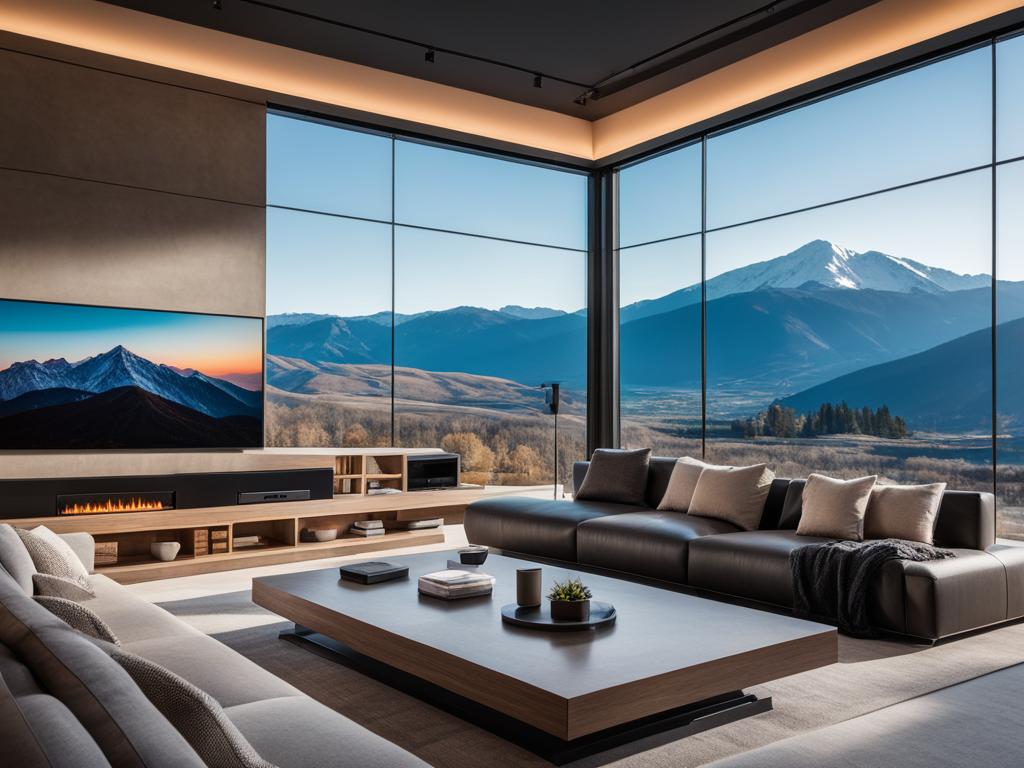
By integrating these smart and sustainable features into your modern mountain home, you create an environment that is both stylish and environmentally friendly. These features not only enhance your daily living experience but also contribute to the long-term sustainability of your home, allowing you to enjoy the beauty of nature while minimizing your ecological impact.
Making the Most of Architectural and Interior Details
Architectural and interior details are essential elements in creating a stunning and cohesive design for a modern mountain home. By paying attention to these details, you can elevate the overall aesthetic and create a space that is both visually appealing and inviting. Here are some key factors to consider:
- Wall Color: Choosing the right wall color is crucial in setting the tone for your modern mountain home. Opt for earthy hues that evoke the natural beauty of the surrounding landscape, such as warm browns, soft greens, or serene blues.
- Textiles: Cozy textiles play a significant role in creating a warm and comfortable atmosphere. Incorporate plush rugs, soft throws, and textured pillows that invite you to unwind and relax in your mountain retreat.
- Inviting Furniture: Select furniture pieces that are not only stylish but also comfortable and inviting. Opt for plush sofas and chairs with soft upholstery and add cushions for extra coziness. Create cozy reading nooks with oversized armchairs and floor lamps.
- Ample Lighting: Proper lighting is essential for highlighting architectural and interior details. Incorporate a variety of light sources, such as floor lamps, table lamps, and pendant lights, to create a warm and inviting ambiance throughout the space.
- Artwork: Incorporating artwork adds a personal touch to your modern mountain home and brings a taste of the outdoors inside. Consider displaying vintage travel posters or nature-inspired paintings that reflect the beauty of the surrounding area.
- Wallpaper: Wallpaper can be used to add texture and patterns that complement the overall design theme. Consider using wallpaper as an accent wall to create visual interest or in smaller spaces like powder rooms or home offices to make a statement.
By considering these architectural and interior details, you can create a visually stunning and inviting modern mountain home that perfectly captures the natural beauty of its surroundings.
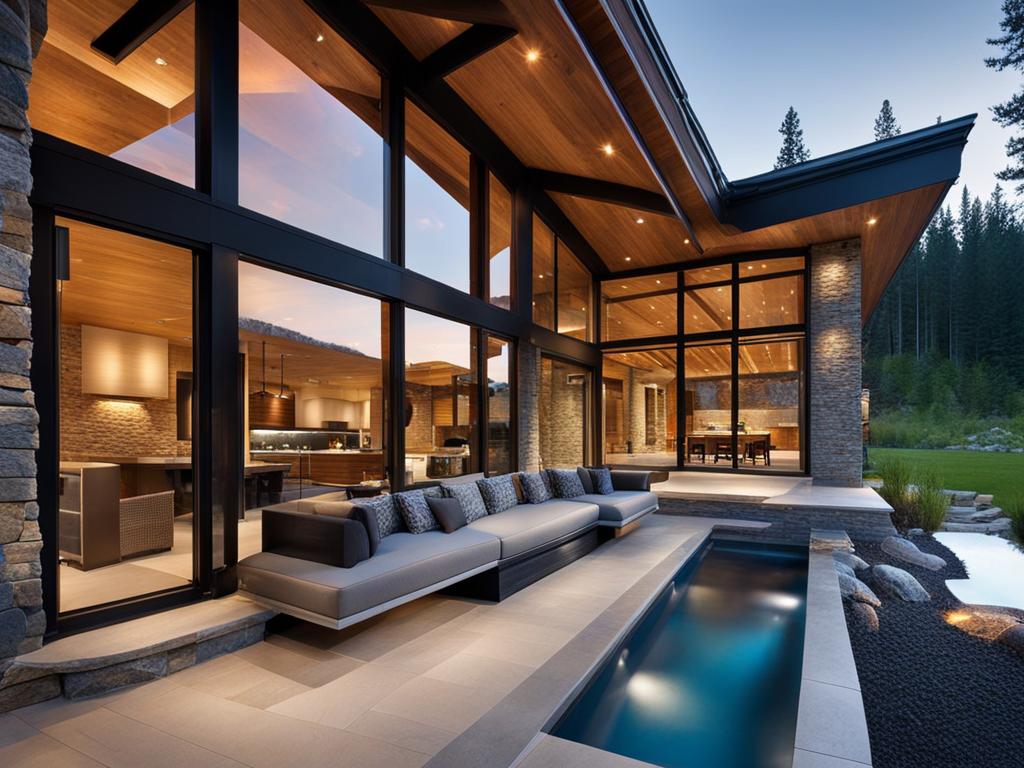
The Charm of Soft Curves in Modern Mountain Design
While modern mountain homes have traditionally emphasized sleek features and hard edges, the current trend is shifting towards incorporating soft curves. This design choice adds a touch of elegance and creates a more inviting and organic atmosphere within each room.
One way to introduce soft curves is through the use of curved walls. By replacing straight lines with gentle curves, you can soften the overall look of the space and create a sense of flow. Curved walls can be particularly effective in common areas such as living rooms or dining rooms, where they can serve as focal points and add visual interest.
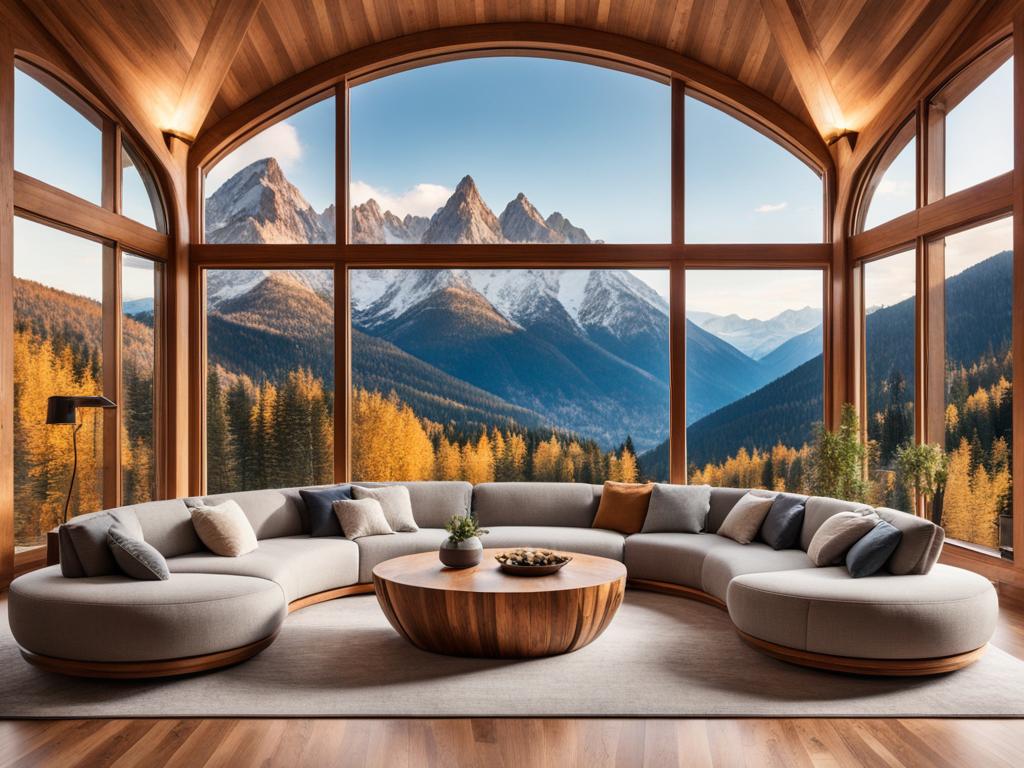
Another way to embrace soft curves is by incorporating curved furniture, such as sectional sofas or chairs with rounded contours. This not only adds comfort but also creates a sense of harmony and softness in the room. Curved furniture pieces can be placed strategically to break up the angular lines of a space and create a more inviting atmosphere.
The use of soft curves in modern mountain design enables a balance between modern sophistication and natural charm. It adds a layer of elegance and softness to the sleek features and hard edges typically associated with this style, resulting in a more welcoming and visually appealing environment.
Conclusion
Designing a modern mountain house is all about creating a harmonious blend of nature, luxury, and sustainability. By incorporating natural materials, such as wood and stone, you can bring the beauty of the outdoors inside. Embracing natural light and open floor plans allows for a seamless connection between the interior and the surrounding landscape.
Adding personal touches with local and vintage treasures creates a unique and inviting atmosphere. Choose furniture and decor that tell a story and reflect the rich history of the area. Not only does this add character to your modern mountain home, but it also supports local artisans and businesses.
When designing your modern mountain house, sustainability should be at the forefront. Consider incorporating energy-efficient appliances, smart home features, and eco-friendly materials. By doing so, you not only reduce your carbon footprint but also create a space that is environmentally conscious and sustainable for the long term.
Follow these tips and design a modern mountain house that combines the best of nature, luxury, and sustainability. Create a retreat that embraces the beauty of the outdoors while providing a comfortable and stylish living space. Enjoy the tranquility and serenity of mountain living in a home that is in perfect harmony with its surroundings.
FAQ
What is modern mountain house design?
Modern mountain house design combines elements of rustic charm with sleek and contemporary aesthetics, blending the natural beauty of mountain landscapes with modern living.
What are the key elements of mountain modern style?
Mountain modern style showcases the fusion of rustic elements inspired by mountain landscapes with modern design principles, emphasizing natural materials, clean lines, minimal ornamentation, and ample natural light.
What natural materials are commonly used in mountain modern design?
Wood, stone, fur, natural fibers like jute and sisal, and leather are commonly used natural materials in mountain modern design.
How do you create a serene color palette for mountain home interiors?
A restrained color palette primarily composed of calming neutrals, such as shades of white, beige, gray, and brown, creates a serene backdrop for mountain home interiors.
How can you embrace natural light and open floor plans in a modern mountain home?
Embrace natural light in a modern mountain home by incorporating oversized windows that offer unobstructed views and utilize open floor plans to allow natural light to flow throughout the home.
How can you bring the outdoors in with balconies, decks, and porches?
You can bring the outdoors in by designing balconies, upper-level decks, and porches as comfortable and accessible spaces for relaxation, entertainment, and enjoying the fresh air.
What types of roofs are commonly used in modern mountain homes?
Sloped roofs are commonly used in mountain homes for practicality in snowy regions, but flat roofs are also prominent in modern architecture and can be adapted for mountain modern homes in milder weather regions.
How can you create depth and dimension with two-tone flooring?
Two-tone flooring involves combining different materials such as wood and stone to create distinct sections or patterns on the floor, adding visual interest and depth to the space.
How can you incorporate local and vintage treasures into a modern mountain home design?
Incorporate local and vintage treasures into a modern mountain home design by sourcing materials from local vendors and incorporating antique and vintage pieces, adding personalization and character to the space.
What are some sustainable features to incorporate into a modern mountain home?
Some sustainable features to incorporate into a modern mountain home include smart home features, energy-efficient appliances, skylights, and LED lightbulbs.
How can you make the most of architectural and interior details in a modern mountain home?
Pay attention to architectural and interior details by choosing the right wall color, incorporating cozy textiles and inviting furniture, displaying artwork, and using wallpaper to add texture and patterns that complement the overall design theme.
How can you incorporate soft curves into modern mountain design?
Embrace soft curves in modern mountain design by incorporating curved walls and curved furniture, adding elegance and organic atmosphere to each room.
What are some essential tips for designing a modern mountain house?
Essential tips for designing a modern mountain house include incorporating natural materials, embracing natural light, creating seamless connections between indoor and outdoor spaces, personalizing with local and vintage treasures, integrating sustainable features, and paying attention to architectural and interior details.

